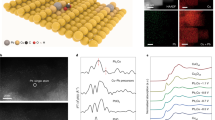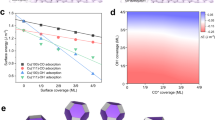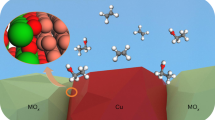Abstract
The development of low-temperature fuel cells for clean energy production is an appealing alternative to fossil-fuel technologies. CO is a key intermediate in the electro-oxidation of energy carrying fuels and, due to its strong interaction with state-of-the-art Pt electrodes, it is known to act as a poison. Here we demonstrate the ability of Earth-abundant Cu to electro-oxidize CO efficiently in alkaline media, reaching high current densities of ≥0.35 mA cm−2 on single-crystal Cu(111) model catalysts. Strong and continuous surface structural changes are observed under reaction conditions. Supported by first-principles microkinetic modelling, we show that the concomitant presence of high-energy undercoordinated Cu structures at the surface is a prerequisite for the high activity. Similar CO-induced self-activation has been reported for gas–surface reactions at coinage metals, demonstrating the strong parallels between heterogeneous thermal catalysis and heterogeneous electrocatalysis.

This is a preview of subscription content, access via your institution
Access options
Access Nature and 54 other Nature Portfolio journals
Get Nature+, our best-value online-access subscription
$29.99 / 30 days
cancel any time
Subscribe to this journal
Receive 12 digital issues and online access to articles
$119.00 per year
only $9.92 per issue
Buy this article
- Purchase on Springer Link
- Instant access to full article PDF
Prices may be subject to local taxes which are calculated during checkout





Similar content being viewed by others
Data availability
All the data supporting the findings of this study are available within the paper and its Supplementary Information files. The datasets generated during and/or analysed during the current study are available from the corresponding author on reasonable request.
Code availability
The scripts used for the modified microkinetic simulations using the open source CatMAP code are given separately from the Supplementary Information in the following GitHub repository: https://github.com/mieand/COelectroCATMAPfiles.git.
Change history
04 January 2021
A Correction to this paper has been published: https://doi.org/10.1038/s41929-020-00565-y.
References
Gilman, S. The mechanism of electrochemical oxidation of carbon monoxide and methanol on platinum. J. Phys. Chem. 68, 70–80 (1964).
Markovic, N. M. & Ross, P. N. Surface science studies of model fuel cell electrocatalysts. Surf. Sci. Rep. 45, 117–229 (2002).
Korzeniewski, C., Climent, V. & Feliu, J. M. in Electroanalytical Chemistry: A Series of Advances Vol. 24 (eds Bard, A. J. & Zoski, C.) 75–169 (CRC Press, 2011).
Koper, M. T. M., Lai, S. C. S. & Herrero, E. in Fuel Cell Catalysis: A Surface Science Approach (ed. Koper, M. T. M.) 159–207 (Wiley, 2008).
García, G. & Koper, M. T. M. Carbon monoxide oxidation on Pt single crystal electrodes: Understanding the catalysis for low temperature fuel cells. ChemPhysChem 12, 2064–2072 (2011).
Edens, G. J., Hamelin, A. & Weaver, M. J. Mechanism of carbon monoxide electrooxidation on monocrystalline gold surfaces: Identification of a hydroxycarbonyl intermediate. J. Phys. Chem. 100, 2322–2329 (1996).
Blizanac, B. B., Arenz, M., Ross, P. N. & Markovic, N. M. Surface electrochemistry of CO on reconstructed gold single crystal surfaces studied by infrared reflection absorption spectroscopy and rotating disk electrode. J. Am. Chem. Soc. 126, 10130–10141 (2004).
Rodríguez, P., Koverga, A. A. & Koper, M. T. M. Carbon monoxide as a promoter for its own oxidation on a gold electrode. Angew. Chem. 122, 1263–1265 (2010).
Rodríguez, P., García-Araez, N. & Koper, M. T. M. Self-promotion mechanism for CO electrooxidation on gold. Phys. Chem. Chem. Phys. 12, 9373–9380 (2010).
Iwasita, T. & Ciapina, E. G. in Handbook of Fuel Cells Vol 5,6 (eds Vielstich, W. et al.) 1–16 (Wiley, 2010).
Roberts, J. L. & Sawyer, D. T. Electrochemical oxidation of carbon monoxide at gold electrodes. Electrochim. Acta 10, 989–1000 (1965).
Kita, H., Nakajima, H. & Hayashi, K. Electrochemical oxidation of CO on Au in alkaline solution. J. Electroanal. Chem. 190, 141–156 (1985).
Sun, S. G., Cai, W., Bin, Wan, L. J. & Osawa, M. Infrared absorption enhancement for CO adsorbed on Au films in perchloric acid solutions and effects of surface structure studied by cyclic voltammetry, scanning tunneling microscopy, and surface-enhanced IR spectroscopy. J. Phys. Chem. B 103, 2460–2466 (1999).
Chang, S.-C., Hamelin, A. & Weaver, M. J. Dependence of the electrooxidation rates of carbon monoxide at gold on the surface crystallographic orientation: a combined kinetic-surface infrared spectroscopic study. J. Phys. Chem. 95, 5560–5567 (1991).
Rodríguez, P., Feliu, J. M. & Koper, M. T. M. Unusual adsorption state of carbon monoxide on single-crystalline gold electrodes in alkaline media. Electrochem. Commun. 11, 1105–1108 (2009).
Rodríguez, P., García-Araez, N., Koverga, A., Frank, S. & Koper, M. T. M. CO electroxidation on gold in alkaline media: A combined electrochemical, spectroscopic, and DFT Study. Langmuir 26, 12425–12432 (2010).
Eren, B., Heine, C., Bluhm, H., Somorjai, G. A. & Salmeron, M. Catalyst chemical state during CO oxidation reaction on Cu(111) studied with ambient-pressure X-ray photoelectron spectroscopy and near edge X-ray adsorption fine structure spectroscopy. J. Am. Chem. Soc. 137, 11186–11190 (2015).
Xu, F. et al. Redox-mediated reconstruction of copper during carbon monoxide oxidation. J. Phys. Chem. C. 118, 15902–15909 (2014).
Konnik, E. I. Electrochemical oxidation of carbon monoxide in aqueous solutions. Russ. Chem. Rev. 42, 111–119 (1973).
Newton, M. A. Dynamic adsorbate/reaction induced structural change of supported metal nanoparticles: heterogeneous catalysis and beyond. Chem. Soc. Rev. 37, 2644–2657 (2008).
Schlögl, R. Heterogeneous catalysis. Angew. Chem. Int. Ed. 54, 3465–3520 (2015).
Reuter, K. Ab initio thermodynamics and first-principles microkinetics for surface catalysis. Catal. Lett. 146, 541–563 (2016).
Eren, B. et al. Activation of Cu(111) surface by decomposition into nanoclusters driven by CO adsorption. Science 351, 475–478 (2016).
Kodama, K., Morimoto, Y., Strmcnik, D. S. & Markovic, N. M. The role of non-covalent interactions on CO bulk oxidation on Pt single crystal electrodes in alkaline electrolytes. Electrochim. Acta 152, 38–43 (2015).
Kunze-Liebhäuser, J. in Encyclopedia of Interfacial Chemistry. Surface Science and Electrochemistry Vol. 5 (ed. Wandelt, K.) 107–120 (Elsevier, 2018).
Strehblow, H.-H. & Titze, B. The investigation of the passive behaviour of copper in weakly acid and alkaline solutions and the examination of the passive film by ESCA and ISS. Electrochim. Acta 25, 839–850 (1980).
Kautek, W. & Gordon, J. G. II XPS studies of anodic surface films on copper electrodes. J. Electrochem. Soc. 137, 2672–2677 (1990).
Scott, S. B. et al. Absence of oxidized phases in Cu under CO reduction conditions. ACS Energy Lett. 4, 803–804 (2019).
Maurice, V., Strehblow, H.-H. & Marcus, P. In situ STM study of the initial stages of oxidation of Cu(111) in aqueous solution. Surf. Sci. 458, 185–194 (2000).
Salimon, J., Hernández-Romero, R. M. & Kalaji, M. The dynamics of the conversion of linear to bridge bonded CO on Cu. J. Electroanal. Chem. 538–539, 99–108 (2002).
Shaw, S. K. et al. Role of axially coordinated surface sites for electrochemically controlled carbon monoxide adsorption on single crystal copper electrodes. Phys. Chem. Chem. Phys. 13, 5242–5251 (2011).
Hori, Y., Koga, O., Watanabe, Y. & Matsuo, T. FTIR measurements of charge displacement adsorption of CO on poly- and single crystal (100) of Cu electrodes. Electrochim. Acta 44, 1389–1395 (1998).
Arihara, K., Kitamura, F., Ohsaka, T. & Tokuda, K. Characterization of the adsorption state of carbonate ions at the Au(111) electrode surface using in situ IRAS. J. Electroanal. Chem. 510, 128–135 (2001).
Zamlynny, V. & Lipkowski, J. in Advances in Electrochemical Science and Engineering Vol. 9 (eds. Alkire, R. C. et al.) 315–376 (Wiley-VCH Verlag GmbH & Co. KGaA, 2006).
Baz, A. & Holewinski, A. Understanding the interplay of bifunctional and electronic effects: Microkinetic modeling of the CO electro-oxidation reaction. J. Catal. 384, 1–13 (2020).
Kunze, J., Maurice, V., Klein, L. H., Strehblow, H.-H. & Marcus, P. In situ STM study of the effect of chlorides on the initial stages of anodic oxidation of Cu(111) in alkaline solutions. Electrochim. Acta 48, 1157–1167 (2003).
Wang, J. et al. Formation, migration, and reactivity of Au–CO Complexes on Gold Surfaces. J. Am. Chem. Soc. 138, 1518–1526 (2016).
Citrin, P. H. & Wertheim, G. K. Photoemission from surface-atom core levels, surface densities of states, and metal-atom clusters: A unified picture. Phys. Rev. B 27, 3176–3200 (1983).
Blyholder, G. Molecular orbital view of chemisorbed carbon monoxide. J. Phys. Chem. 68, 2772–2778 (1964).
Andersen, M., Medford, A. J., Nørskov, J. K. & Reuter, K. Analyzing the case for bifunctional catalysis. Ang. Chem. Int. Ed. 55, 5210 (2016).
Andersen, M., Medford, A. J., Nørskov, J. K. & Reuter, K. Scaling-relation-based analysis of bifunctional catalysis: The case for homogeneous bimetallic alloys. ACS Catal. 7, 3960 (2017).
Necas, D. & Klapetek, P. Gwyddion: an open-source software for SPM data analysis. Cent. Eur. J. Phys. 10, 181–188 (2012).
Auer, A. & Kunze-Liebhäuser, J. A universal quasi-reference electrode for in situ EC-STM. Electrochem. Commun. 98, 15–18 (2019).
Tiwari, A., Maagaard, T., Chorkendorff, I. & Horch, S. Effect of dissolved glassware on the structure-sensitive part of the Cu(111) voltammogram in KOH. ACS Energy Lett. 4, 1645–1649 (2019).
Medford, A. J. et al. CatMAP: A software package for descriptor-based microkinetic mapping of catalytic trends. Catal. Lett. 145, 794–807 (2015).
Giannozzi, P. et al. QUANTUM ESPRESSO: A modular and open-source software project for quantum simulations of materials. J. Phys. Condens. Matter 21, 395502 (2009).
Perdew, J. P., Burke, K. & Ernzerhof, M. Generalized gradient approximation made simple. Phys. Rev. Lett. 77, 3865–3868 (1996).
Garrity, K. F., Bennett, J. W., Rabe, K. M. & Vanderbilt, D. Pseudopotentials for high-throughput DFT calculations. Comput. Mater. Sci. 81, 446–452 (2014).
Acknowledgements
A.A. is a recipient of a doctorate (DOC) Fellowship of the Austrian Academy of Sciences at the Institute of Physical Chemistry. E.-M.W. and J.K.-L. acknowledge funding by the Austrian Science Foundation (FWF) through grant I-4114. N.G.H. and K.R. acknowledge funding by the Deutsche Forschungsgemeinschaft (DFG, German Research Foundation) under Germany´s Excellence Strategy – EXC 2089/1 – 390776260. F.J. Sarabia, V. Climent and J. Feliu from the University of Alicante made us aware of the importance of avoiding glassware in the Cu(111) electrochemistry. We thank them for allowing us to repeat some electrochemical experiments in their Teflon based equipment. Additionally, we thank B. Kindler for assistance with preparation of the Cu single crystals.
Author information
Authors and Affiliations
Contributions
J.K.-L and K.R. supervised and coordinated the project. A.A and E.-M.W. designed and conducted the experiments. A.A. carried out the cyclic voltammetry and in situ EC-STM experiments. E.-M.W. conducted the in situ EC-IRRAS measurements. A.A. and N.B. did the RDE measurements. N.G.H. performed the DFT calculations and M.A. performed the microkinetic modelling. A.A., M.A., E.-M.W., K.R. and J. K.-L. contributed to the manuscript writing. All authors discussed and revised the manuscript.
Corresponding author
Ethics declarations
Competing interests
The authors declare no competing interests.
Additional information
Publisher’s note Springer Nature remains neutral with regard to jurisdictional claims in published maps and institutional affiliations.
Extended data
Extended Data Fig. 1 Current transients show high electrocatalytic reversibility.
Potential steps to -0.63VSHE (black) and -0.45VSHE (grey), showing the high reversibility of CO oxidation on Cu(111). The reference potential was set to -0.85VSHE. Insets: current densities versus step number.
Extended Data Fig. 2 Control EC-STM studies in CO-free electrolyte.
EC-STM at -0.45 VSHE in Ar-saturated 0.1 M NaOH, where the surface is imaged over a long period of time (> 1.5 hours). In comparison to the structural changes during the CO bulk oxidation at the exact same potential, the images in the CO-free 0.1 M NaOH indicate unidirectional Cu transport upon Cu(111) reconstruction. Although a high degree of step edge roughening due to OH adsorption-induced reconstruction can be observed, there is only little formation of nanoscale Cu adatom islands. A much higher stability of the surface morphology after reconstruction is observed. No additional growth of adatom islands and nanostructures is seen upon scanning of up to an hour, which means there is no apparent surface diffusion. a, 100 x 100 nm2 (Itip = 1 nA) and b–d, 50 x 50 nm2 (Itip = 4 nA). Etip = -0.5 VSHE.
Extended Data Fig. 3 Electronic structure analysis of OH and CO on Cu adatoms at Cu(111).
Atom and momentum projected PDOS of a, OH and b, CO adsorbed on top of a Cu adatom (labelled as Cuad) located in the fcc site of Cu(111). All results are from SCCS implicit solvation calculations, which allow an absolute alignment of the energy scale with the vacuum level and the simulation of appropriate molecular reference states, namely CO(aq) and charged OH-(aq). The Fermi level (EF) and d-band centres are indicated by dashed and dotted lines. c, The charge-density difference plot for OH-(aq) adsorption indicates partially remaining negative charge on the Cuad–OH complex. The shown isosurface corresponds to 0.0135e/Å3 (red) and -0.0135e/Å3 (blue), the purple region indicates the implicit solvation cavity. d, The changes in the 3d PDOS of adsorbed Cuad and of surface Cu(111) show the significant difference of CO adsorption as compared to OH.
Supplementary information
Supplementary Information
Supplementary Figs. 1–11, Table 1, Notes 1–10, input files, and references 1–25.
Rights and permissions
About this article
Cite this article
Auer, A., Andersen, M., Wernig, EM. et al. Self-activation of copper electrodes during CO electro-oxidation in alkaline electrolyte. Nat Catal 3, 797–803 (2020). https://doi.org/10.1038/s41929-020-00505-w
Received:
Accepted:
Published:
Issue Date:
DOI: https://doi.org/10.1038/s41929-020-00505-w
This article is cited by
-
Dynamics of bulk and surface oxide evolution in copper foams for electrochemical CO2 reduction
Communications Chemistry (2024)
-
Atomic-scale surface restructuring of copper electrodes under CO2 electroreduction conditions
Nature Catalysis (2023)
-
Machine learning speeds up search for surface structure
Nature Computational Science (2023)
-
Electrochemical Scanning Tunneling Microscopy as a Tool for the Detection of Active Electrocatalytic Sites
Topics in Catalysis (2023)
-
Active site identification and engineering during the dynamic evolution of copper-based catalysts for electrocatalytic CO2 reduction
Science China Chemistry (2023)



